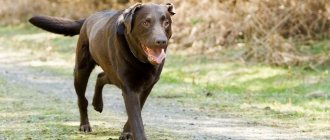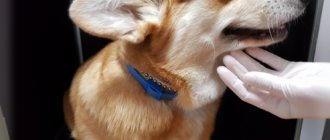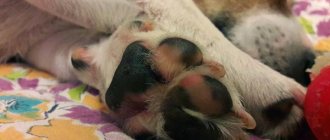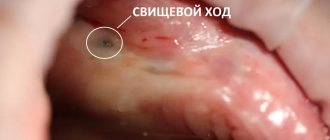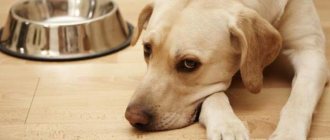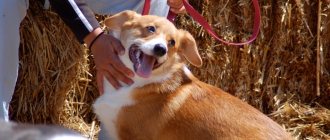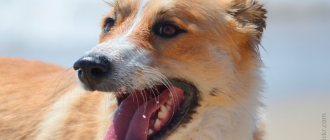Quite often, owners are faced with the problem of lameness in their dogs. The causes of the disease can be very diverse, for example, injury or joint disease. Lameness is a partial or complete loss of mobility that can affect one or both legs. The symptom is detected immediately, as the dog’s gait changes, which is expressed in the asymmetry of the pet’s movements. Lameness itself is not a disease. It is rather a symptom indicating some other problem.
Lameness is a sign of internal impairment or external damage
What is lameness
When an animal's gait changes due to a step disorder, they speak of lameness.
In this case, the dog does not step completely on the problematic limb, trying to redistribute the body weight onto healthy paws. At rest, the animal tucks its affected leg.
The front paws are most often damaged because they bear the brunt of the load when jumping and running.
How does lameness manifest?
Even without signs of visible damage, you can understand that your pet has problems with its limbs.
The following symptoms will help identify lameness:
the inability of the animal to lean on the sore leg;- pain when walking and at rest;
- inability to stand on the problematic limb from a lying position;
- specific cracking in the joints.
If the pain is severe, the pet will whine and lick its paw. When leaning on a sore limb, the dog stretches its neck forward and throws back its head.
In addition to general signs, there are also other symptoms that characterize the type of disease and the degree of complication.
Sprains
A sprain, unlike a bruise, occurs when there is awkward movement in a joint. The main symptom is pain during intense movement or jumping, as well as when palpating the problem area. In the absence of ligament rupture, the sprain usually resolves without consequences.
Recommendations for helping with sprains:
- Limiting the animal’s mobility (it’s enough just not to force the dog to run and jump - it takes care of the damaged joint itself).
- Cold on the first day after injury, warm the next 2-3 days.
With such injuries in dogs, treatment in the clinic is not required as often. The exception is situations when bruises accompany more serious injuries (they almost always accompany fractures). It is also worth contacting your veterinarian if the symptoms of sprain do not go away within 3-4 days.
Types of lameness
Depending on the factor that provoked the problem, lameness can be different and manifest itself in different ways.
Types of lameness in animals
| Lameness | Description |
| leaning limb | Soreness occurs when the animal tries to stand on the problematic paw. At the same time, it shows restlessness, refuses to move, whines, and sometimes trembles. Pathology occurs when ligaments, tendons, bones are damaged, pads or claws are injured. |
| hanging limb | Painful symptoms appear when the dog tries to move its paw. Muscle injury is to blame here. |
| mixed type | There are signs of the two previous types. The problem is provoked by inflammatory processes affecting large joints (knees, hips, etc.) |
Painful symptoms can be different in nature, depending on the severity of the damage to the limb.
Functional disorders in animals are divided into 3 degrees:
The first includes mild lameness, in which the dog is able to briefly place emphasis on the problematic limb, but tries to step on the paw as little as possible to avoid pain.- Second degree: the pet tries to avoid stepping on the affected limb and carries it forward or presses it forward.
- the third degree is characterized by spasmodic movement of the dog due to the fact that it is generally unable to lean on the affected paw or even move it.
Lameness in dogs is classified according to other parameters depending on the causes of the disease.
Congenital leg defects
There is such a thing as intermittent claudication (also called Patella's disease). She appears suddenly and quickly disappears. It affects dwarf breeds, for which luxation of the kneecap is a common occurrence.
This does not cause any particular problems for the dog, but if repeated frequently, such lameness can lead to degenerative changes.
Another pathology that is inherited is Perthes disease. It is more typical for dwarfs, but the genetic disease can also appear in puppies of other breeds.
Lameness is provoked by deformation of joint and bone tissues that occurs against the background of suddenly developing necrosis.
All other types of lameness are acquired. They can be triggered by mechanical injuries and chemical damage, organ diseases, infections, etc.
Risk group. Predisposition
There are several groups of dogs that have a predisposition to lameness (or rather, pathologies that cause lameness):
- small breed dogs have a genetic disease - Legg-Calvé-Perthess disease, which is not typical for large breeds;
- In dogs of large breeds, hip dysplasia is not uncommon, while in small dogs this disease does not occur;
- Also, large breed dogs between the ages of 4 and 8 years often experience rupture of the anterior cruciate ligament;
- Specifically, in Rottweilers, fragmentation of the sesamoid bones is more common than others;
- Large breed puppies may have weak wrist syndrome during active growth. This happens when the muscles and ligaments “do not keep up” with the growth of bones, as a result - the wrist is constantly in a strongly bent or straightened state;
- dogs approaching their old age always have a risk of cancer;
- Obese animals are also at risk.
Causes of the condition
If a dog is limping on its front leg, first of all find out what is causing it. There are several most common reasons, and each of them can cause serious trouble for your pet.
Injuries of varying severity
It is the mechanical effect on tissue that most often causes lameness. A dog can also get injured during normal walking.
Even minor pad abrasions can cause pain and change your pet's stride. These include the following points:
cuts and puncture wounds;- splinters;
- joint bruises upon impact;
- sprains;
- dislocations;
- bone fractures.
Even snow packed between the toes can cause injury to an animal's paw. Mechanical damage also includes insect bites and poisonous reptiles.
Diseases
Dogs, like people, are susceptible to pathologies of joints, muscles, and bones. Among the main inflammatory diseases of the musculoskeletal system, it is worth highlighting arthritis and osteoarthrosis, which are the result of another serious lesion - dysplasia. The cartilage tissues of the joints of large and medium-sized pets suffer from this.
Not only older animals can get sick. Sometimes the musculoskeletal system is also affected in a young dog. The reason for this is old injuries, excessive exercise and poor nutrition.
Cyst between fingers
Short-haired dogs are more likely to suffer from this problem. The etiology of the disease has not been fully determined by scientists.
The root cause of the appearance of nodules is considered to be damage to the subcutaneous tissue, sebaceous glands, hair follicles caused by mechanical, chemical, thermal, parasitic, and infectious effects.
Chemical or thermal burns
Both high and low temperatures can impair the motor function of a pet.
In the first case, boiling water may accidentally fall on the dog, or the animal may jump onto a hot sheet of metal.
The second situation is possible in severe frosts, when there is a risk of frostbite on the paws.
Your pet will also get a burn if it comes into contact with aggressive liquids, such as stepping on spilled alkali, acid, fuel oil or gasoline.
In winter, animals often burn the pads of their limbs after walking on snow-covered roads, which are treated for ice with special reagents.
Dislocations
A dislocation is an injury that affects a joint. When a dislocation occurs, the natural position of the articular surfaces is disrupted, and they cannot spontaneously return to their place. Characteristic features:
- Swelling at the joint (swelling and inflammation occur at the site of tissue damage).
- Soreness of the damaged area.
- Restricted mobility in a joint or, conversely, unnatural mobility (the limb bends in a way it shouldn’t).
When a dislocation occurs, it is important to ensure basic immobilization of the animal's limb so that bone displacement does not cause additional damage. After this, the dog should be taken to the clinic as quickly as possible - under no circumstances should you adjust the dislocation yourself. Severe dislocations can be extremely painful, so pain relief for a dog with this type of injury is given quite often - this helps to avoid shock.
Note! It is also undesirable to apply cold to the site of dislocation - cooling the joint can make it difficult to reduce it. Therefore, it is necessary to cool the injury site only for a short period of time, and only if the animal feels severe discomfort.
Diagnostics: can it be done at home?
If the dog begins to behave with caution, it can be assumed that there are problems with its paws. The owner carefully examines the dog to look for signs of damage.
If they are not detected, but the animal reacts painfully to touch, it is recommended to test it in motion.
The pet's stride is assessed in several gaits. If there are no problems with the musculoskeletal system, then the movements will be smooth, springy, and free.
If there are barely noticeable signs of lameness, it is recommended to walk your pet along wet sand and carefully examine the paw prints. When a dog has pain in a limb, it carries it out with a twist inward.
If you measure the length of your step, it will be shorter than usual, and the footprint of the affected leg will be weaker than the others.
For further diagnosis, the pet is taken to a veterinary clinic for a hardware examination, where the dog is x-rayed in 2 projections (frontal and lateral). If the picture is unclear, a computed tomography scan is additionally prescribed.
Wounds and bleeding
A wound is one of the most common injuries in dogs. Most often, this term refers to any injury accompanied by damage to the skin. Bleeding almost always begins when the dog is injured, but sometimes it can appear later - this is typical, for example, of injuries received in a fight with other animals.
According to the type of application and the nature of damage to the skin and tissues, wounds are divided into:
- Biting is a consequence of a fight with another dog or cat.
- Torn - can be obtained in a fight or due to severe damage. They are characterized by significant size, profuse bleeding and tearing off flaps of skin. Injuries to claws in dogs that are excessively long can also be accompanied by lacerations: the claw, acting as a lever, simply tears off the skin and injures blood vessels.
- Cuts - dogs most often get them by stepping on glass or other sharp objects. Accordingly, the paw pads are usually affected, and the extent of the damage directly depends on the dog’s weight.
- Split - characterized by a small area and large depth of penetration. This often happens if the dog runs into a nail or sharp object. Most cases affect the trunk rather than the limbs. The main danger of a puncture wound is hidden damage to internal organs.
- Gunshots are another very dangerous category of wounds. With a gunshot wound, a bullet, shot or buckshot can penetrate deep into the body, causing heavy bleeding - both internal and external.
A wound is not always a reason to visit a veterinarian. The regenerative abilities of dogs are very good, so minor damage to the skin heals either without human intervention or with a little help from the owner.
When processing independently:
- The wound is cleaned of dirt and objects that have gotten into it.
- Torn small fragments of skin are also carefully removed (it is better to do this right away, because the likelihood that a thin flap will take root is small, but it may begin to rot).
- The wound is washed and treated with an antiseptic.
- The edges of the wound are tightened and fixed with a sterile bandage.
- After primary healing has begun, the damaged area is treated with creams and ointments.
If the wound is deep and extensive, there is heavy bleeding or there is a risk of damage to internal organs, you need to take the dog to a veterinarian as soon as possible. In this case, the main task of the owner is to stop bleeding and prevent infection of the wound:
- To stop bleeding, it is necessary to clamp the vessels through which blood flows. This is done manually, using a pressure bandage or tourniquet.
- You can prevent the wound from becoming infected by covering it with a sterile cloth and securing it with a bandage.
Is it possible to ignore lameness in a dog?
The lameness may be minor (for example, the pet has slightly twisted its paw, but is running) and will go away on its own. Still, such symptoms cannot be ignored, because this may be a sign of an incipient serious disease of the bones and joints, including oncology.
Lameness is not always associated with limb problems. Sometimes it becomes a concomitant symptom of vertebral hernia, heart disease, gastrointestinal tract and other internal problems.
How to treat
Even a slight bruise of the paw should not be ignored, hastening to provide all possible assistance to the pet. Treatment of lameness is carried out after clarifying the cause that caused it.
| Factor | Recommendations |
| Minor damage | Cuts or wounds on the paw pads are treated with hydrogen peroxide |
| Splinters | If there is deep damage to soft tissue, you will need medical alcohol. They moisten a cotton swab and apply it to the wound after the foreign object is removed from the paw. |
| Insect bites | At home, help is provided to the pet if the swelling is minor. The bite site is treated with a solution of soda (in a ratio of 1:10). When the dog is stung by a bee, the injured area is smeared with garlic juice. But if the animal has an allergic reaction to the bite, it is immediately sent to a veterinary clinic. An emergency visit to the doctor should also occur in case of a tarantula bite |
| Ticks | The problem occurs in the spring and summer. If the tick is not removed in time, the dog may die from encephalitis. To prevent this from happening, the pet is periodically examined to identify the attached insect. The detected pest must be removed, adhering to the following rules:
If you don’t have tweezers at hand, you can use a thick thread. But this requires skill |
| Dislocations and sprains | In this situation, the joint must be secured with a tight bandage and the pet taken to the doctor. Painful symptoms can be relieved by applying ice to the injured paw. |
| Fractures | You should not take the initiative here, because the slightest touch to the limb will cause severe pain in the dog. As a result, the animal can involuntarily injure its owner. All necessary assistance will be provided to the pet under anesthesia in the hospital. |
Minor lameness without damage quickly disappears if the dog is not stressed for a while. After the animal lies quietly for several days, it will be able to move actively again.
If there are no apparent reasons: owner actions
When, upon examining the pet, the owner is convinced that there are no visible injuries, he should not ignore the dog's lameness, even if the animal does not feel severe pain.
Such a problem does not arise because of trifles.
After observing the symptoms, the owner provides the pet with peace and, if necessary, provides all possible assistance. You should immediately call a veterinarian to your home so that he can assess the extent of the problem.
In situations where there is no time to wait for a specialist to arrive, the owner independently transports the dog to the hospital.
Bruises
A dog's bruise is a fairly common injury, but rarely noted by owners. This is due to the fact that the animal’s pain threshold is quite high, so bruises without external signs (severe swelling or crushing) go unnoticed under the fur.
A bruise occurs when struck by a blunt object, and is usually accompanied by either the appearance of a bruise or the formation of a subcutaneous swelling (hematoma):
- In the first day after a bruise, it is advisable to limit the spread of swelling by applying cold to the damaged area.
- After 24 hours, minor bruises go away on their own. If the hematoma remains, it is advisable to warm it up (a heating pad, a bandage with heated salt) for 15-20 minutes 3-4 times a day.
- The skin at the site of the bruise is lubricated 2 times a day with special ointments that resolve the hematoma.
Prevention
If there are congenital pathologies, lameness is difficult to prevent. As for external factors, the owner is able to protect his four-legged friend from them.
It is enough to follow the basic rules:
choose suitable places for walking with minimal risk of bites and injuries;- do not overload the dog with physical activity during exercise, selecting exercises that are feasible for the animal;
- Carry out daily examinations of your pet to promptly identify injury or disease.
A balanced diet plays an important role in a dog’s health. The mineral components included in the feed strengthen bones and blood vessels and make muscle tissue elastic. This helps prevent the animal from developing problems with its limbs.
Preventive actions
The following steps will help you avoid lameness:
- Proper animal care.
- Balanced diet.
- Regular examination of the limbs (at least once a week). Paws must be examined after going to the forest or mountains.
- In winter, small dogs should wear special shoes.
- Timely trimming of nails.
- Washing paws with soap after every walk, removing dirt from the spaces between the toes.
- Trimming the fur between the fingers.
- Tracking the degree and complexity of physical activity.
- Compliance with breed breeding rules (closely related unions are excluded, animals with hereditary diseases should not participate in breeding).
- When walking, avoid dangerous places (where there are a lot of stones, glass, branches, etc.).
- Minimize contact with other animals.
If lameness is detected in a pet, the problem should not be ignored under any circumstances. It is better to show the dog to a veterinarian and make sure that there is no cause for concern, or if a serious pathology is detected, start treatment on time.
